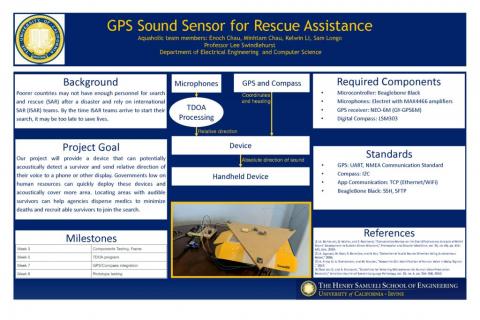GPS Sound Sensor for Rescue Assistance
In response to developing countries’ dependence on inefficient international search and rescue teams (ISAR), the GPS Sound Sensor (GPSSS) is a device that can detect the direction of a sound source using time delay of arrival (TDOA) processing. Ultimately, the goal is to send data into an Android App and display the direction of the sound source and the location and orientation of the device. A potential future addon for this device is detecting that the sound source is from a human (rather than an animal), thus decreasing false positives and becoming more reliable [1].
The GPSSS’s main purpose is to be used in search and rescue (SAR) after natural disasters. SAR teams in developing countries do not usually have the manpower or funding to cover wide areas to search for survivors. Non-government organizations such as Red Cross or other ISAR teams often arrive too late to help and save lives. The probability of finding a survivor drops drastically with time (90% of rescues occur within 24 hours) [2]. Without the manpower of ISARs, local governments and agencies could be low on human resources. This device can somewhat relieve the lack of personnel and acoustically cover more area with lower costs than maintaining SAR teams. ISAR is often a costly endeavor for little benefit [2] and the hope is to offer an option to aid local SAR teams to respond to natural disasters.
TDOA processing involves finding the time difference between the microphones when the microphone picks up the same signal. To detect direction on a 2D plane, three microphones are used. Currently, the device has 18° of accuracy and only reliably picks up constant sound sources at low frequencies (<400Hz).

